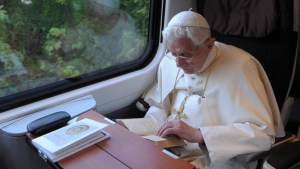Lenten Campaign 2025
This content is free of charge, as are all our articles.
Support us with a donation that is tax-deductible and enable us to continue to reach millions of readers.
Lectio divina is a form of contemplative prayer in the monastic tradition, based on the meditative reading of Sacred Scripture. The devotion consists of various components — reading, meditation, prayer, and contemplation — and is designed to make our hearts and minds receptive to God’s voice through scripture. It thus allows us to develop a more intimate relationship with the Lord.
Pope Benedict XVI once said that if lectio divina were more widely promoted, there would be a new springtime of the faith. But, if this is the case, why haven’t we heard more about it? And just what is lectio divina, anyway?
Lectio divina is a Latin term meaning “sacred reading.” The active part of it — lectio — is quite a bit different from what we’re used to. While we read a newspaper for news, a novel for entertainment, and social media to keep up with friends and the news of the world, in lectio divina we “read” to place ourselves in the presence of God and to begin a conversation with him.
“Lectio divina is an ancient Christian practice, developed especially in monasteries, whereby we read Holy Scripture and other writings that have a direct bearing on the Faith in a prayerful, meditative, and heartfelt manner, pausing from time to time to meditate on what is being read,” said Benedictine Fr. Philip Anderson, abbot of Our Lady of the Annunciation Abbey in Clear Creek, Oklahoma. “It is something like drawing water out of a deep well (a very biblical image) instead of from a faucet.”
Our reading in lectio divina is a vehicle; there is no set formula for what or how much we need to read. Usually, the readings are taken from the Bible, which is, after all, one of the main ways God has spoken — and continues to speak — to man. Lectio divina drives home the fact that the Bible is the living Word of God, which continues to speak to us, even as it spoke to the prophets and poets and evangelists who first composed the Scriptures.
Where did the practice come from?
The 12th century Carthusian monk Guigo is often cited as the Christian thinker who formalized lectio divina. “Reading puts, as it were, whole food into your mouth; meditation chews it and breaks it down; prayer finds its savor; contemplation is the sweetness that so delights and strengthens,” Guigo wrote in a letter to a fellow religious (Scala Paradisi).
The practice has been fostered over the centuries by Benedictine monks, in particular, but also Trappists and Carmelites as well as lay people seeking a deeper prayer life.
“Renew and Create,” a statement from the 36th general chapter of the American-Cassinese Congregation of the Order of St. Benedict issued in 1969, explains the importance of lectio divina to the life of the Benedictine: “The reflective pondering of the word of God aims at giving the monk an awareness of God’s presence, a consciousness of the immersion of his life in the mystery of God’s activity as revealed in sacred history.”
Why should it be practiced?
“Lectio divina fosters the divine life planted in us through baptism, and thus helps us attain eternal beatitude in God,” Fr. Anderson told Aleteia. “It also strengthens all the virtues we need in order to live our daily lives while we are still on earth.”
Pope Benedict, in an address during an international congress on “Sacred Scripture in the Life of the Church” in 2005, quoted the Second Vatican Council’s definition of lectio divina: “The diligent reading of Sacred Scripture accompanied by prayer brings about that intimate dialogue in which the person reading hears God who is speaking, and in praying, responds to him with trusting openness of heart” (Dei Verbum, 25). “If it is effectively promoted, this practice will bring to the Church — I am convinced of it — a new spiritual springtime,” Benedict said.
“As a strong point of biblical ministry, lectio divina should therefore be increasingly encouraged, also through the use of new methods, carefully thought through and in step with the times,” the Pope said. “It should never be forgotten that the Word of God is a lamp for our feet and a light for our path (cf. Psalm 119[118]:105).”
Karen Dwyer and her husband, Larry, responded to the Pope’s call to encourage lectio divina, and have themselves developed a new method of practicing it. Last year, they published a booklet titled WRAP Yourself in Scripture.
“To make it easy, I started teaching this acronym — ‘WRAP’ — to help people learn to do it,” she explained. “‘W’ stands for write: Pick out a section of scripture and begin to read it. As St. Philip Neri said, when a word or verse of Scripture seems to rise into your heart, that would be the beginning of what the Lord wants to bring to life to you. So write down that verse in your journal.
“‘R’ stands for reflect: Meditation means to ponder, to consider, to mull something over. It can also be a recitation. You go over the passage and begin to think of its meaning. You begin to ponder it before the Lord and invite the Lord into discussion. You begin to let it come to life in your heart.”
“‘A’ stands for apply it: Prayerfully begin to talk to the Lord. He brought it to your attention, and you’ve been pondering it, so he is going to want to help you apply it. Maybe he’s going to want to bring forgiveness or healing into your heart.
“‘P’ stands for praying: Pray about whatever comes to your heart. At that point, you just sit back and remain silent; come into that rest where the Holy Spirit and Jesus are totally present to you.”
Is this a sentimental approach? Is it the same as “centering prayer”?
“Real lectio divina is quite alien to the sort of experience that is sought in order to ‘feel’ divine consolations,” said Fr. Anderson. “It is a quest to meet the giver of consolations, not a quest for consolations. Unlike ‘centering prayer,’ which includes a somewhat ambiguous reference to practices borrowed from oriental religions (‘Transcendental Meditation’), lectio divina is part of a long Christian tradition. As this is a living tradition, there can be new developments, but the essence of lectio is quite different from ‘centering prayer.’”
As lectio divina becomes more popular, Anderson advises the faithful seeker to be cautious of popular books written by anyone who really does not know much about it or “who is promoting an ‘agenda’ that has nothing to do with that adoration ‘in spirit and in truth’ about which our Lord spoke to the Samaritan woman, near Jacob’s well. If we have the courage to just read Holy Scripture with the Church (one must have that guidance at least), not relying much on human genius, then all will be well.”
He adds, “It would be invaluable to be able to consult with a monk or nun with experience in lectio divina.”
How can people get into it?
If you want to hear God speaking, you need to create silence. This seems to be especially needed today, in a world where so many concerns are vying for our attention. In many ways, new technologies such as the Internet and smartphones have invaded spaces of our lives that were formerly quiet and private.
“The best way to start is to set aside a quiet moment (at least 10-15 minutes) in the early part of the day, and to read a page or two of the Bible, along with a good Catholic study guide or good footnotes,” Fr. Anderson advises. “The key is to persevere until this becomes a habit, thereby creating a spiritual space where the Holy Spirit can operate in the soul, increasing the gifts of the Holy Spirit and a spiritual understanding of the Word of God. One should begin by a short prayer to the Holy Spirit.”
Perhaps the best way for a beginner to get started and to feel confident that he’s practicing lectio divina correctly is to follow the Pope’s lead. Benedict explained the steps of lectio divina in his 2010 Post-Synodal Apostolic Exhortation, Verbum Domini:
“It opens with the reading (lectio) of a text, which leads to a desire to understand its true content: what does the biblical text say in itself? Without this, there is always a risk that the text will become a pretext for never moving beyond our own ideas.
“Next comes meditation (meditatio), which asks: what does the biblical text say to us? Here, each person, individually but also as a member of the community, must let himself or herself be moved and challenged.
“Following this comes prayer (oratio), which asks the question: what do we say to the Lord in response to his word? Prayer, as petition, intercession, thanksgiving and praise, is the primary way by which the word transforms us.
“Finally, lectio divina concludes with contemplation (contemplatio), during which we take up, as a gift from God, his own way of seeing and judging reality, and ask ourselves what conversion of mind, heart and life is the Lord asking of us.
“In the Letter to the Romans, St. Paul tells us: ‘Do not be conformed to this world, but be transformed by the renewal of your mind, that you may prove what is the will of God, what is good and acceptable and perfect’ (12:2). Contemplation aims at creating within us a truly wise and discerning vision of reality, as God sees it, and at forming within us ‘the mind of Christ’ (1 Cor 2:16). The word of God appears here as a criterion for discernment: it is ‘living and active, sharper than any two-edged sword, piercing to the division of soul and spirit, of joints and marrow, and discerning the thoughts and intentions of the heart’ (Heb 4:12). We do well also to remember that the process of lectio divina is not concluded until it arrives at action (actio), which moves the believer to make his or her life a gift for others in charity.
“We find the supreme synthesis and fulfillment of this process in the Mother of God,” the Pope concludes. “For every member of the faithful, Mary is the model of docile acceptance of God’s word, for she ‘kept all these things, pondering them in her heart’ (Lk 2:19; cf. 2:51); she discovered the profound bond which unites, in God’s great plan, apparently disparate events, actions, and things.”
What if I’m too busy?
“We have only a very short time in this life,” Karen Dwyer, co-author of the WRAP book, told Aleteia. “Since this life is about eternity and lectio divina is about developing a deepening conversation and relationship with the help of the Holy Spirit so that you hear Christ in your heart, I think it’s the first thing you should do. If you put the Lord and your relationship with him first, it will be life changing. It will reflect in your life and will put things into perspective. I wouldn’t want to start a day without spending time with the Lord and letting him speak to me through his word.”



